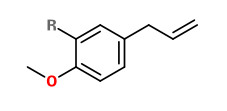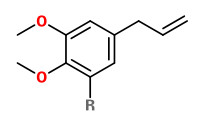Dies ist eine alte Version des Dokuments!
Artemisia dracunculus L. - syn.Artemisia inodora Willd. - Asteraceae - tarragon, Estragon
Probably native to East Europe and Northwest Asia, naturalized in Europe, Asia, North America, cultivated especially in France; upright aromatic perennial, 0.60-1.20m high; stems mostly numerous, branched; leaves smooth, not divided, linear, glabrous, entire, 2-10cm long; flowerheads pendulous, nearly globoid, 2-3mm in diameter; tiny greenish flowers with strong aromatic smell.
„French tarragon is the variety generally considered best for the kitchen, but is never grown from seed as the flowers are sterile; instead it is propagated by root division… Tarragon is one of the four fines herbes of French cooking, and is particularly suitable for chicken, fish and egg dishes. Tarragon is the main flavoring component of Béarnaise sauce. Fresh, lightly bruised sprigs of tarragon are steeped in vinegar to produce tarragon vinegar.“ http://en.wikipedia.org/wiki/Tarragon
„The main components of the essential oil from Artemisia dracunculus L., as there are sabinene, methyl eugenol, estragole and elemicine, are present in variable quantities depending on the season.“
[Über die Zusammensetzung des ätherischen Öls aus Artemisia dracunculus L. während der Vegetationsperiode. Helmut Ihm, Robert Zintl, Karl Knobloch, Z Naturforsch. 36 c, 724-727 (1981)]
 estragole (methyl chavicol, R=H), methyl eugenol (R=OCH3)
estragole (methyl chavicol, R=H), methyl eugenol (R=OCH3)
„French and Russian tarragon, Artemisia dracunculus L., leaves have glandular hairs distributed over the whole surface and secretory cavities arranged in files along the major veins in the mesophyll. Chemical composition analysis of leaves, leaf epidermis, and leaf mesophyll by hydrodistillation and solvent extraction indicate quantitative differences in composition between the epidermis and the mesophyll. The main components in the essential oils, methyl chavicol in French tarragon and elemicin and methyl eugenol in the Russian tarragon, were observed to accumulate primarily in the mesophyll.“
[Glandular hairs, secretory cavities, and the essential oil in the leaves of tarragon (Artemisia dracunculus L.). Werker, Ella, et al., Journal of Herbs, Spices & Medicinal Plants 2.3 (1994): 19-32]
„The essential oil of Artemisia dracunculus L. of Cuban origin has been analyzed by GC and GC/MS. Forty-two compounds were identified, of which elemicin (53.0%) and methyl eugenol (17.6%) were the major constituents.“
[Chemical composition of the essential oil of Artemisia dracunculus L. from Cuba. Pino, Jorge A., et al., Journal of Essential Oil Research 8.5 (1996): 563-564]
„Gas chromatography (GC)/mass spectrometry (MS) analysis of the essential oil revealed the presence of trans-anethole (21.1%), α-trans-ocimene (20.6%), limonene (12.4%), α-pinene (5.1%), allo ocimene (4.8%), methyl eugenol (2.2%), β-pinene (0.8%), α-terpinolene (0.5%), bornyl acetate (0.5%) and bicyclogermacrene (0.5%) as the main components. “
[Anticonvulsant activity and chemical composition of Artemisia dracunculus L. essential oil. Sayyah M1, Nadjafnia L, Kamalinejad M.J, Ethnopharmacol. 2004 Oct;94(2-3):283-7]
„A. dracunculus oil contained predominantly phenylpropanoids such as methyl chavicol (16.2%) and methyl eugenol (35.8%).“
[Screening of chemical composition, antimicrobial and antioxidant activities of Artemisia essential oils. Lopes-Lutz D, Alviano DS, Alviano CS, Kolodziejczyk PP, Phytochemistry. 2008 May;69(8):1732-8]
„Artemisia dracunculus L. (tarragon) has a long history of use as a spice and remedy. Two well-described “cultivars” (Russian and French) are used widely and differ in ploidy level, morphology, and chemistry. Key biologically active secondary metabolites are essential oils (0.15-3.1%), coumarins (>1%), flavonoids, and phenolcarbonic acids. In vivo studies mainly in rodents, particularly from Russian sources, highlight potential anti-inflammatory, hepatoprotective, and antihyperglycemic effects. Despite concerns about the toxic effects of two of its main constituents, estragole (up to 82%) and methyleugenol (up to 39%), no acute toxicity or mutagenic activity has been reported at doses relevant for human consumption. Water extracts of A.
dracunculus contain very low amounts of estragole and methyleugenol and, therefore, are considered to pose a very limited risk. Overall, a stronger focus on clinical studies and precise taxonomic and phytochemical definition of the source material will be essential for future research efforts.“
[Artemisia dracunculus L. (Tarragon): A Critical Review of Its Traditional
Use, Chemical Composition, Pharmacology, and Safety., Dmitry Obolskiy, Ivo Pischel, Bjoern Feistel, Nikolay Glotov, and Michael Heinrich, J Agric Food Chem. Vol.59(21), 2011, 11367-11384]

